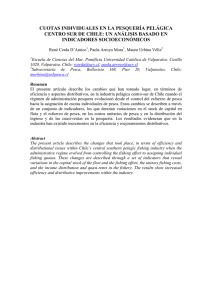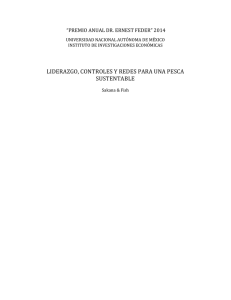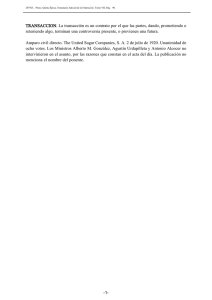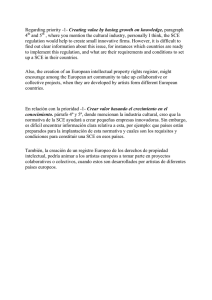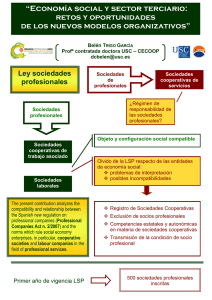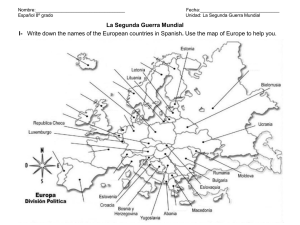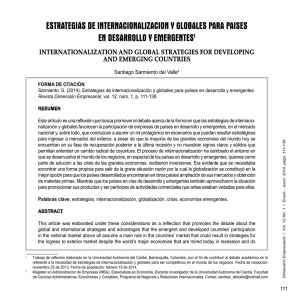¿porqué la internacionalización de las empresas pesqueras
Anuncio
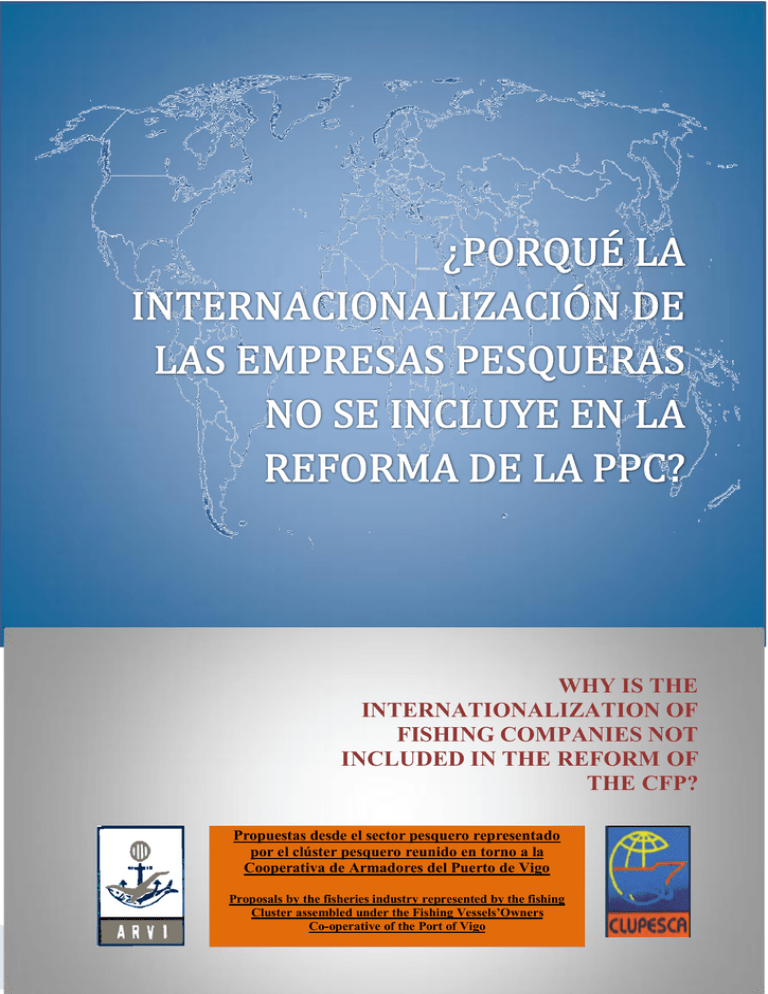
~1~ WHY IS THE INTERNATIONALIZATION OF FISHING COMPANIES NOT INCLUDED IN THE REFORM OF THE CFP? Propuestas desde el sector pesquero representado por el clúster pesquero reunido en torno a la Cooperativa de Armadores del Puerto de Vigo Proposals by the fisheries industry represented by the fishing Cluster assembled under the Fishing Vessels’Owners Co-operative of the Port of Vigo 1 ¿POR QUÉ LA INTERNACIONALIZACIÓN DE LAS EMPRESAS PESQUERAS NO SE INCLUYE EN LA REFORMA DE LA PPC WHY IS THE INTERNATIONALIZATION OF FISHING COMPANIES NOT INCLUDED IN THE REFORM OF THE CFP? OCTUBRE/OCTOBER 2012 Cooperativa De Armadores De Pesca Del Puerto De Vigo, S. Coop. Ltda. Cluster del Sector Pesquero Extractivo y Productor Puerto Pesquero, Edificio Ramiro Gordejuela. Apdo. 1078. 36202 Vigo (España) Telef.: +34 986433844 / Fax: +34 986439218 / E mail: [email protected] Web: www.arvi.org 2 Cooperativa de Armadores de Pesca del Puerto de Vigo, S. Coop. Gallega Cluster del Sector Pesquero Extractivo y Productor ¿POR QUÉ LA INTERNACIONALIZACIÓN DE LAS EMPRESAS PESQUERAS NO SE INCLUYE EN LA REFORMA DE LA PPC INDICE Página 1. INTRODUCCIÓN ........................................................................................................... 4 2. LOS DATOS ................................................................................................................... 4 2.1. LAS INVERSIONES EN TERCEROS PAÍSES ........................................................... 5 2.2. LAS EXPORTACIONES ........................................................................................... 6 3. ¿CUAL ES LA OPINION DE LA UE SOBRE LA INTERNACIONALIZACIÓN DE SUS EMPRESAS? .......................................................................................................................... 9 4. ENTONCES ¿POR QUÉ LA REFORMA DE LA PPC NO HABLA DE ESTE OBJETIVO? 9 5. CONCLUSIONES............................................................................................................ 9 6. PROPUESTAS DE ACTUACIÓN ................................................................................. 10 3 Cooperativa de Armadores de Pesca del Puerto de Vigo, S. Coop. Gallega Cluster del Sector Pesquero Extractivo y Productor ¿POR QUÉ LA INTERNACIONALIZACIÓN DE LAS EMPRESAS PESQUERAS NO SE INCLUYE EN LA REFORMA DE LA PPC 1. INTRODUCCIÓN La internacionalización de las empresas europeas es un factor clave para la competitividad de las mismas ante un mundo cada vez más globalizado e interconectado. Europa es una de las economías más abiertas del mundo, pero la competencia por parte de economías desarrolladas y emergentes es cada vez mayor. En el sector pesquero, nuestras empresas llevan muchos años compitiendo sin apenas barreras arancelarias 1 y una parte de ellas también lleva mucho tiempo inmersa en un proceso continuo de internacionalización a través de las exportaciones de pescado y/o de las inversiones pesqueras que llevan a cabo en países terceros 2. La Estrategia 2020 de la Unión Europea para el crecimiento nos deja claro que se debe promover un crecimiento sostenible a través del comercio mundial, mediante las exportaciones y las importaciones; así como las inversiones en países terceros. Por ello; uno de los objetivos clave para poder seguir siendo competitivos es el de promover la internacionalización de las empresas comunitarias. El objetivo de este Informe es poner de manifiesto el que, a pesar de la tradicional apuesta de las empresas pesqueras europeas en exportar sus productos y salir al exterior, este punto fuerte no se recoge en la reforma de la PPC. Pretendemos con ello sensibilizar a los políticos, gestores y a la opinión pública en general, de la necesidad de que una Política común como es la Pesquera APOYE EXPRESAMENTE LA INTERNACIONALIZACÓN DE LAS EMPRESAS PESQUERAS COMO FACTOR NECESARIO PARA UN CRECIMIENTO SOSTENIBLE DE LA ECONOMIA EN LAS REGIONES ALTAMENTE DEPENDIENTES DE LA PESCA. 2. LOS DATOS Los dos elementos esenciales de la internacionalización son las inversiones en terceros países y las exportaciones: 1 2 El pescado como materia prima es uno de los productos cuya tarifa aduanera común es de las más bajas Tanto en buques de pesca como en plantas frigoríficas y de transformación de pescado, etc. 4 ARVI / CLUPESCA 2.1. LAS INVERSIONES EN TERCEROS PAÍSES Las empresas pesqueras comunitarias tienen una larga tradición en inversiones en países terceros, tanto en la adquisición de buques como en la instalación de plantas, frigoríficos, plantas de elaboración, etc, en tierra. El ejemplo más representativo es el de las empresas asociadas en torno al Clúster de Empresas Pesqueras en Países Tercero (CEPPT). En este Clúster están asociadas 118 empresas con 321 barcos que operan en 24 países de todo el mundo3. Estas inversiones permiten una producción, tanto a bordo como en tierra, en torno a 420.000 toneladas de pescado anuales que, mayoritariamente, se destinan al mercado comunitario. En cuanto al empleo a bordo de los barcos, hay unos 1.500 tripulantes comunitarios y unos 6.500 no comunitarios. En tierra (plantas de elaboración) se da empleo a varios miles de trabajadores, lo que permite fijar población en estos territorios Kiribati Islas Seychelles 3 Ver “clusterdepesca.es” y “transparentsea.co” 5 ARVI / CLUPESCA 2.2. LAS EXPORTACIONES Si bien es cierto que la UE es deficitaria en productos de la pesca y la acuicultura siendo, junto a Japón y a EE.UU., uno de los tres principales importadores del mundo, también es cierto que las exportaciones, tanto intra como extracomunitarias, también van creciendo cada año, lo que supone un factor de internacionalización creciente de las empresas pesqueras comunitarias: EXPORTACIONES 2010 PAÍS (*) TONELADAS EUROS 1.745.739 SE 571.295 DK 892.303 UK 493.416 NL 878.373 2.476.255 DE 761.991 1.717.599 FR 296.654 1.123.134 ES 1.013.673 2.450.963 2.685.474 1.456.139 (*)SE=Suecia; DK=Dinamarca; UK= Reino Unido; NL= Holanda; DE= Alemania; FR= Francia; ES= España Fuente: La Política Pesquera Común en cifras (2012). Comisión Europea Vemos como Dinamarca, Holanda y España se sitúan a la cabeza de los países exportadores con el 43% del total. Después, y a más distancia, le siguen Suecia, Alemania, Reino Unido y Francia. 6 ARVI / CLUPESCA Por productos, las exportaciones se distribuyen de la siguiente forma (valor en miles de euros. Total de intercambios intra y extracomunitarios) : Productos congelados Productos frescos y refrigerados 1.511.102 1.188.312 SE DK UK NL FR ES DE 775.349 681.820 565.214 460.635 314.890 DE 735.015 DK 720.400 FR SE DE NL ES UK FR 337.645 1.543.989 Total EU-27 6 363 136 Productos ahumados, en salazón, secos 282.309 252.932 171.133 141.996 95.321 92.813 69.823 557.995 OTROS Total EU-27 6 685 090 DK 1.120.392 NL UK 1.187.768 OTROS 1.347.700 ES Preparados y conservas 506.755 ES DK 418.209 NL 403.197 363.024 DE 594.145 FR 167.266 1.170.934 OTROS OTROS Total EU-27 1 700 472 Total EU-27 3 029 385 Fuente: La Política Pesquera Común en cifras (2012). Comisión Europea Vemos como los productos frescos, seguidos de los congelados y los preparados y conservas, son los principales productos que se exportan, tanto dentro como fuera de la UE. 7 ARVI / CLUPESCA En cuanto a nuestros principales clientes, EE.UU (11%), Suiza (9%), Rusia (8%), Noruega (8%), China (8%) y Japón (7%) son los países que más solicitan nuestros productos. 8 ARVI / CLUPESCA 3. ¿CUAL ES LA OPINION DE LA UE SOBRE LA INTERNACIONALIZACIÓN DE SUS EMPRESAS? La Estrategia 20204 nos dice que la UE debe promover un crecimiento sostenible en todas sus actividades económicas, a través del comercio mundial, mediante las exportaciones y las importaciones de materias primas y productos acabados, así como las inversiones en países terceros. Por ello, uno de los objetivos clave para poder seguir siendo competitivos es el de PROMOVER LA INTERNACIONALIZACIÓN DE LAS EMPRESAS COMUNITARIAS. 4. ENTONCES ¿POR QUÉ LA REFORMA DE LA PPC NO HABLA DE ESTE OBJETIVO? Esta es una pregunta que, de momento, no tiene respuesta. No sabemos porque la propuesta de la Comisión sobre la reforma de la PPC no contiene ningún artículo relativo a la promoción o al apoyo de la internacionalización de las empresas pesqueras comunitarias, tal como recomienda la Estrategia 2020. No sabemos si se debe a un olvido o si la Comisión considera que para las empresas pesqueras comunitarias no es importante el apoyo a la internacionalización de las mismas. 5. CONCLUSIONES Es evidente que el sector pesquero comunitario necesita competir con el resto del mundo para abastecer no solo al mercado comunitario sino también a los países terceros que año tras año van aumentando el consumo per capita de pescado, habida cuenta de los efectos saludables del mismo. Por ello, no se entiende por qué la propuesta de la Comisión sobre la reforma de la PPC no contempla el apoyo a la internacionalización de las empresas pesqueras en su doble vertiente: las inversiones en terceros países y las exportaciones. Y no se entiende porque en la hoja de ruta que nos marca la Estrategia EUROPA 2020 viene claramente indicado este apoyo como factor de competitividad y crecimiento de la economía comunitaria. 4 Ver COM(2010)2020: Una Estrategia para un crecimiento inteligente, sostenible e integrador 9 ARVI / CLUPESCA 6. PROPUESTAS DE ACTUACIÓN La reforma de la PPC debería contener en su articulado relativo a la política exterior5 unos artículos nuevos que recojan los siguientes puntos: a) La Unión Europea apoyará la internacionalización de las empresas pesqueras comunitarias con el fin de lograr un crecimiento económico sostenible, tal como plantea la Estrategia 2020. Este apoyo abarcará los siguientes campos de actuación: El establecimiento de cláusulas de protección recíprocas de inversiones en los acuerdos que la UE tiene o vaya a tener con los países terceros en los que existan inversiones pesqueras comunitarias Facilidades crediticias y de avales para las empresas pesqueras comunitarias que exporten sus productos pesqueros y/o inviertan en países terceros. b) Crear una red telemática a nivel comunitario que permita mejorar la transparencia de la información sobre las inversiones pesqueras en países terceros con el fin de hacer un seguimiento sobre el cumplimiento de estos países en materia de sostenibilidad marina, social y económica. 5 10 Parte VII del COM(2011) 425 final ARVI / CLUPESCA 11 ARVI / CLUPESCA 12 Cooperativa de Armadores de Pesca del Puerto de Vigo, S. Coop. Gallega Cluster del Sector Pesquero Extractivo y Productor WHY IS THE INTERNATIONALIZATION OF FISHING COMPANIES NOT INCLUDED IN THE REFORM OF THE CFP? INDEX Page 1. INTRODUCTION ........................................................................................................ 14 2. THE DATA .................................................................................................................. 14 2.1. INVESTMENTS IN THIRD COUNTRIES ............................................................... 15 2.2. EXPORTS ............................................................................................................. 16 3. WHAT IS THE EU’s OPINION ON THE INTERNATIONALIZATION OF ITS COMPANIES? ..................................................................................................................... 19 4. SO, WHY DOES THE REFORM OF THE CFP NOT DEAL WITH THIS OBJECTIVE? 19 5. CONCLUSIONS............................................................................................................ 19 6. PROPOSALS FOR ACTION......................................................................................... 20 13 Cooperativa de Armadores de Pesca del Puerto de Vigo, S. Coop. Gallega Cluster del Sector Pesquero Extractivo y Productor WHY IS THE INTERNATIONALIZATION OF FISHING COMPANIES NOT INCLUDED IN THE REFORM OF THE CFP? 1. INTRODUCTION The internationalization of European companies is a key factor for their competitiveness in an increasingly globalized, interlinked world. Europe is one of the most open economies in the world, but the competition from developed and emerging economies is increasingly greater. In the fishing sector, our companies have been competing for many years now with hardly any customs barriers 6. Some of these companies have long been involved in an on-going process of internationalization in terms of fish exports and/or fishing investments being made in third countries7. Europe 2020, the European Union Growth Strategy makes it clear for us that a sustainable growth should be promoted through world trade, by means of exports and imports, as well as by investments in third countries. For this reason, one of the key objectives to be able to continue to be competitive is to promote the internationalization of European companies. This Report sets out to highlight the fact that, despite the traditional commitment of European fishing companies to export their products and to move abroad, this strong point is not covered by the reform of the CFP. Our aim here is to make politicians, managers and public opinion in general aware of the need for a common Policy such as the Fisheries Policy to EXPRESSY SUPPORT THE INTERNATIONALIZATION OF FISHING COMPANIES AS A NECESSARY FACTOR FOR A SUSTAINABLE GROWTH OF THE ECONOMY IN REGIONS THAT ARE HIGHLY DEPENDENT ON FISHING. 2. THE DATA The two essential elements of internationalization are investments in third countries and exports: 6 7 14 Fish as a raw material is one of the products whose customs tariff ranks among the lowest. Both in fishing vessels and in coldstore and fish processing plants, etc. ARVI / CLUPESCA 2.1. INVESTMENTS IN THIRD COUNTRIES The EU fishing companies have a long tradition in investments in third countries, both in acquiring vessels and in setting up plants, coldstores, processing plants, etc. on land. The most representative example is that of the associated companies under the Cluster of Fishing Companies in Third Countries (CEPPT). In this Cluster, 118 companies are members, with 321 ships operating in 24 countries around the world8. These investments make it possible to produce, both on board and on shore, around 420,000 tonnes of fish per annum, most of which is forwarded to the European market. In terms of employment on board the ships, there are some 1,500 European crewmembers and some 6,500 non-EU members. On land (processing plants), several thousand workers are employed, which makes it possible to fix population in these territories. Russia Panama Ecuador Peru Chile Morocco Mauritani a Senegal G. Bissau G. Conakry Ivory Cameroon Gabon St. Helena. Congo Rep Angola Namibia Brazil Uruguay Argentina Falkland Islands 8 Kiribati Seychelles Islands Australia 321 Fishing Vessels 118 Associated Companies 25 Countries 420.000 tons per annum 8.000 Jobs See “clusterdepesca.es” and “transparentsea.co” 15 ARVI / CLUPESCA 2.2. EXPORTS While it is a fact that the EU is running at a deficit in fish and aquaculture products being, along with Japan and the U.S.A., one of the three leading importers in the world, it is also true to say that exports, both intra- and extra-community, are also increasing each year. This means an increasing internationalization factor as regards community fishing companies: EXPORTS 2010 COUNTRY (*) TONNES EUROS 1,745,739 SE 571,295 DK 892,303 UK 493,416 NL 878,373 2,476,255 DE 761,991 1,717,599 FR 296,654 1,123,134 ES 1,013,673 2,450,963 2,685,474 1,456,139 (*)SE=Sweden; DK=Denmark; UK= United Kingdom; NL= Holland; DE= Germany; FR= France; ES= Spain Source: The Common Fisheries Policy in figures (2012). European Commission Here we see how Denmark, Holland and Spain rank at the forefront of exporting countries, with 43% of the total. These are followed, by a long way, by Sweden, Germany, United Kingdom and France. 16 ARVI / CLUPESCA Exports by products are distributed as follows (values in thousands of euros. Total number of intra- and extra-community exchanges): Frozen Products Fresh and Chilled Products 1.511.102 1.188.312 SE DK UK NL FR ES DE 775.349 681.820 565.214 460.635 314.890 DE 735.015 DK 720.400 FR SE DE NL ES UK FR 337.645 1.543.989 Total EU-27 6 363 136 Ready-to-serve and canned products Smoked, salted and dried products 282.309 252.932 171.133 141.996 95.321 92.813 69.823 557.995 OTHERS Total EU-27 6 685 090 DK 1.120.392 NL UK 1.187.768 OTHERS 1.347.700 ES 506.755 ES DK 418.209 NL 403.197 363.024 DE 594.145 FR 167.266 1.170.934 OTHERS OTHERS Total EU-27 1 700 472 Total EU-27 3 029 385 Source: The Common Fisheries Policy in figures (2012). European Commission Here we see how fresh products, followed by frozen and ready-to-serve and canned, are the main products for exports, both inside and outside the EU. 17 ARVI / CLUPESCA As far as our main clients are concerned, the U.S.A. (11%), Switzerland (9%), Russia (8%), Norway (8%), China (8%) and Japan (7%) are the countries that most demand our products. 18 ARVI / CLUPESCA 3. WHAT IS THE EU’s OPINION ON THE INTERNATIONALIZATION OF ITS COMPANIES? The Strategy 20209 tells us that the EU must promote a sustainable growth in all its economic activities, via world trade, by means of exports and imports of raw materials and end products, as well as by investments in third countries. To achieve this, one of the key objectives to be able to continue being competitive is that of PROMOTING THE INTERNATIONALIZATION OF EUROPEAN COMPANIES. 4. SO, WHY DOES THE REFORM OF THE CFP NOT DEAL WITH THIS OBJECTIVE? This is a question which, to date, remains unanswered. We do not know why the Commission’s proposal regarding the reform of the CFP does not contain any article in terms of promoting or backing the internationalization of European fishing companies, as recommended by the Strategy 2020. We do not know if this has simply been overlooked or if the Commission considers that, as far as European fishing companies are concerned, it is not important to back the internationalization of the same. 5. CONCLUSIONS It is clear that the European fishing sector needs to compete with the rest of the world in order to supply not only the European market, but also third countries which, year after year, are experiencing an increase in their consumption per capita of fish, as they take into account the healthy effects of the same. For this reason, it cannot be understood why the Commission’s proposal regarding the reform of the CFP does not include backing the internationalization of fishing companies in their twofold focus: investments in third countries and exports. Nor is it understandable why, in the road map set out by the EUROPA Strategy 2020 this support is clearly indicated as a factor of competitiveness and growth of the European economy. 9 See COM(2010)2020: A Strategy for an smart, sustainable and integrating growth 19 ARVI / CLUPESCA 6. PROPOSALS FOR ACTION The reform of the CFP should contain in its articulate regarding external policies 10 new articles covering the following points: a) The European Union shall support the internationalization of European fishing companies in order to achieve a sustainable economic growth, as put forward in the Strategy 2020. This support will involve the following fields of action: - Establish reciprocal protection clauses for investments under the agreements that the EU has or may have with third countries where there are EU fishing investments; - Loan and guarantee facilities for European fishing companies exporting their fish products and/or investing in third countries. b) Create a telematics network, at European level, that will make it possible to improve transparency of information as regards fisheries investments in third countries, in order to carry out follow-up on the compliance of these countries in terms of marine, social and economic sustainability. 10 20 Part VII of the COM(2011) 425 final Cooperativa De Armadores De Pesca Del Puerto De Vigo, S. Coop. Ltda. Cluster del Sector Pesquero Extractivo y Productor Puerto Pesquero, Edificio Ramiro Gordejuela. Apdo. 1078. 36202 Vigo (España) Telef.: +34 986433844 / Fax: +34 986439218 / E mail: [email protected] Web: www.arvi.org
